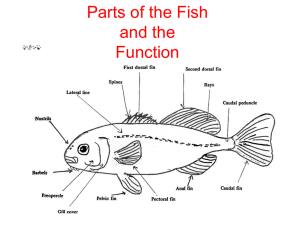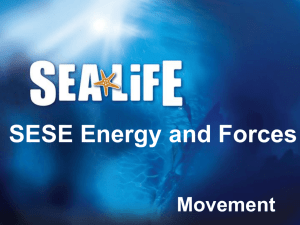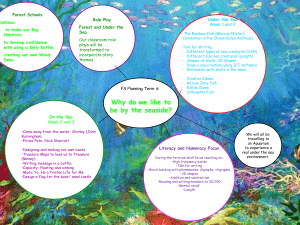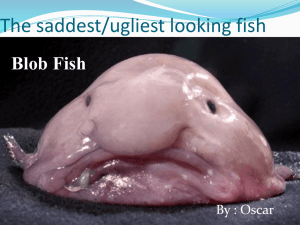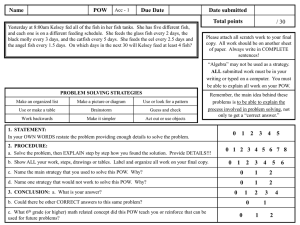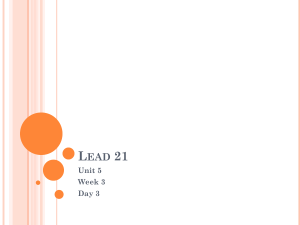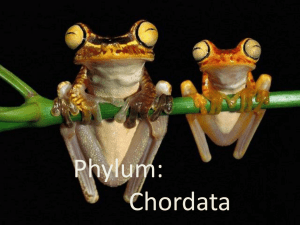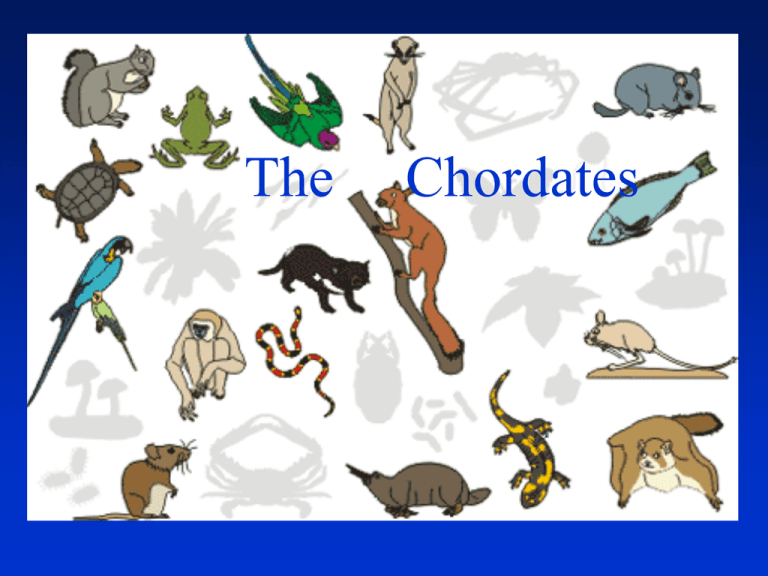
The
Chordates
The Chordates
Possess all 5 Invertebrate Trends, Plus:
– Dorsal nerve (Spinal) cord
– Notochord or backbone/vertebrae
– Tail (at some stage of the life cycle)
– Muscle Blocks
– Gill Slits (at some stage of the life cycle
General Chordate Body Plan
The nerve or spinal cord connected
the elongated body to the brain,
and directed messages very quickly
to distant parts of the body. This
allowed organisms to grow larger
and still be able to send nerve
signals effectively.
The notochord/backbone/vertebrae
added strength and rigidity to an
elongated body, and provided
protection to the spinal cord. This
feature also allowed organisms to
grow larger and provided
attachment sites for muscles.
The tail is an adaptation for
locomotion, both for balance and
for propulsion.
Muscle blocks allowed for muscles
to grow larger and more powerful,
especially since the muscles could
be attached to the internal skeleton.
Gill slits evolved as an adaptation
for larger and/or faster aquatic
creatures to be able to exchange
larger amounts of respiratory
gases. The gills are also thought to
be the structures from which jaws
evolved, a feature that is possessed
by nearly all of the so called
advanced vertebrates.
Compared to the Invertebrates,
the Chordates are:
–
Smarter
– Larger
– More coordinated
– Faster
Three Divisions of Chordates:
» Urochordates
» Cephalochordates
» Vertebrates
Urochordata
- also known as Tunicates
or Sea Squirts.
- live in salt water (marine)
(Illustration from Linzey, 2001)
- are free-floating or sessile.
-chordate features are most evident in the larvae
Cephalochordata
• - aka “lancelets”
ex. Amphioxus
• - are marine - live in sand or shallow water.
• - adults possess all chordate features
Vertebrata
-Some of the 5 chordate features are evident only
during development
- Embryonic
vertebrates have:
- a notochord
- dorsal nerve chord
- gill slits/pouches
(pharyngeal clefts)
Vertebrate Origins
What is the ancestral origin of the
Vertebrates/Chordates?
- no fossil record, therefore only based
on speculation
- one popular hypothesis puts the
chordates as possibly descendant from
the same common ancestor of
echinoderms??
From Romer
Vertebrata
5 classes:
•
•
•
•
•
fish
amphibians
reptiles
birds
mammals
Fish
• First appear in the Paleozoic Era
• Devonian Period is “The Age of Fishes”
Fish are more advanced over their
invertebrate ancestors, in that they
(the advanced fish) possess:
•
•
•
•
Skull
Bones (either cartilaginous or calcified)
Jaws (which evolved from gill slits)
Fins (paired appendages, different from the
appendages of the invertebrates)
Fish Subdivisions
• Agnathans
• Placoderms
• Chondrichthyes
• Osteichthyes
Agnathans
• No jaws – jawless
• Cartilage skeletons
• Lampreys and hagfish
Placoderms
• First fish to have jaws, vertebrae and paired fins
• They are now extinct – below are pictures
reconstructed from fossils:
Jaws evolved when gill openings
in the head became enlarged and
fitted with teeth - an important
adaptation to consume huge
chunks of food, allowing fish to
grow to enormous size.
Placoderms
Vertebrae evolved to enclose the
spinal cord – this added protection
to the spinal cord and provided an
attachment site for muscles allowing for more powerful
movements.
Paired fins improved swimming
ability, allowing fish to swim faster
and with great manoeuvrability.
Other Interesting Facts about Fish:
• Have a 2 chambered heart & a closed circulatory
system
• Are cold blooded (ectotherms)
• Sexually reproduce, but use external fertilization
(males don’t have a penis!)
• Produce jelly-like eggs that must be laid in water
Chondrichthyes
• Skulls smaller – lighter weight
• Skeletons of cartilage – very flexible and
light weight – for greater agility and speed
Sharks
and Rays
Osteichthyes
• The Bony Fishes
• Two types:
1) Lobe Finned Fish
2)Teleosts
Lobe Finned Fish
• Fins in the shape of lobes,
allowing them to walk on
pond bottom or even on land
• Also had primitive lungs for
breathing – did not have to rely on gills, could
be out of water for short periods of time
• Modern day lung fish and coelocanthes
evolved from the lobe finned fish
• Amphibians likely evolved from lobe finned
fish too
Teleosts – Spiny Finned Fish
• Modern fish - name a fish and it’s
probably a teleost !!
• Fins have spines in them for support
• Have a swim bladder to help them be
buoyant at any depth
Amphibians
Frogs, toads, newts and salamanders
In addition to the innovations accomplished by fish,
amphibians have:
• Legs that extend sideways – awkward for both swimming
and walking – but better
than lobes
• Lungs – (though the lobe finned
lung fish also had lungs)
• 3 chambered heart
Crocodiles & Snakes
Reptiles
Turtles & Lizards
And Don’t Forget…
Dinosaurs were reptiles too!!
In addition to the amphibian
characteristics, reptiles also had the
following characteristics that allowed
them to be away from water for
longer, move better and grow larger:
• Dry scaly skin (prevented drying out of
skin, but also prevented breathing thru skin)
• Expandable rib cage (allowed them to
inflate their lungs to a large volume)
• Leather shelled amniote eggs (allowed them
to lay their eggs away from water)
• Copulatory organs (i.e. a penis - for internal
fertilization – the only way for sperms to get
to eggs when animals are living on land !!)
• Legs extending beneath the body (for better
locomotion & supporting more weight)
• 3 and 1/2 chamber heart (for better
separation of oxygenated and deoxygenated
blood – richer blood – more energy)
Birds
Improvements over
reptiles include:
• Feathers
(for insulation and flight)
• Hollow bones
(lighter weight for flight)
• Warm blooded
(allowing for greater energy production)
• Air sacs
(for greater surface area and gas exchange)
• 4 chamber heart
(for complete separation of oxygenated and
deoxyg. blood = richer blood = more energy)
• Hard shelled amniote egg
(more protection from drying out and
from predators)
Mammals
• The Cenozoic Era is known as the “Age of
Mammals”
• In addition to warm blood and a 4 chambered
heart, mammals also possess:
• Milk and Mammary glands
(to nourish young)
• Body hair
(for insulation)
• 3 groups: placentals, monotremes, and marsupials
Placentals
• Possess a placenta which supports the
growth of the embryo until birth – better
chance of survival
Monotremes
• Lay leathery eggs (like reptiles)
Echidna
(spiny ant-eater)
Marsupials
• Give birth to an immature live young - no
larger than a kidney bean
• Wombats, opossums, kangaroos, koalas
The End!



